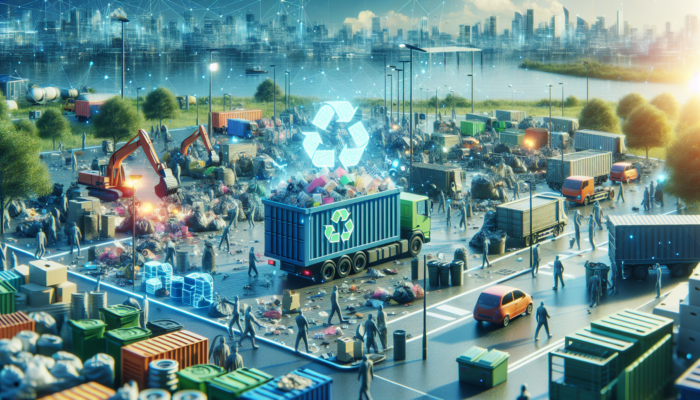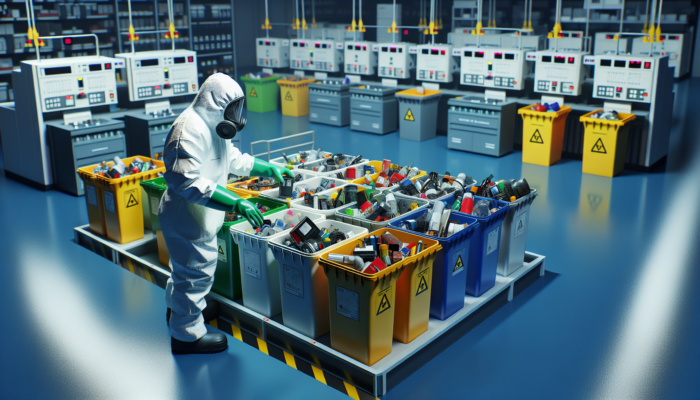Discover Effective Eco-Friendly Clearance Strategies in the UK: Essential Insights and Innovations
Exploring the Significance and Benefits of Eco-Friendly Clearance Methods

Eco-friendly clearance encompasses a range of systematic approaches utilized for the removal of unneeded items or waste, with a strong focus on minimizing environmental impact. This practice has gained significant importance in the UK, where the rising concerns about waste management and environmental sustainability have reached urgent levels. The core of eco-friendly clearance techniques in the UK involves adopting practices that promote sustainability, decrease waste production, and enhance recycling initiatives. By embracing these methods, individuals and businesses not only meet legal obligations but also make meaningful contributions to preserving a healthier ecosystem.
The staggering volume of waste produced annually in the UK underscores the pressing need for effective eco-friendly clearance techniques. Poor disposal practices can result in serious environmental consequences, such as soil erosion and the emission of greenhouse gases. Eco-friendly clearance addresses these challenges by encouraging practices that emphasize recycling, reusing, and reducing waste. By grasping the definitions and importance of these techniques, stakeholders can make well-informed decisions that align with their environmental aspirations and adhere to legal requirements.
Unveiling Recent Innovations in Sustainable Clearance Techniques
As environmental issues continue to evolve, so do the technologies and strategies associated with eco-friendly clearance techniques in the UK. Recent advancements have introduced more effective, efficient, and sustainable methods that radically change traditional clearance processes. For instance, the implementation of cutting-edge waste management systems that utilize Internet of Things (IoT) technology allows for real-time monitoring of waste levels, optimizing collection routes, and significantly cutting down on fuel consumption and harmful emissions.
Moreover, the advent of biodegradable packing materials and sophisticated dismantling tools greatly improves recycling and waste management practices, aligning perfectly with the eco-friendly vision. Additionally, enhancements in sorting technologies facilitate the better separation of recyclable materials from waste, resulting in increased recycling rates and reduced dependence on landfills. These innovations not only streamline operational processes but also promote a more sustainable and responsible approach to waste management.
Navigating the Legal Framework for Compliance and Best Practices
The UK has established a comprehensive legal framework governing waste management and clearance practices, significantly impacting eco-friendly clearance techniques. Key regulations such as the Waste (England and Wales) Regulations 2011 and the Environmental Protection Act 1990 detail the responsibilities of businesses and individuals concerning waste disposal. Adhering to these regulations is essential for any clearance operation, ensuring that waste is managed ethically and responsibly.
In addition to national regulations, local authorities implement specific guidelines and frameworks that must be followed, which may differ from one region to another. A thorough understanding of these regulations is crucial for anyone involved in clearance activities, as non-compliance can result in substantial fines and damage to reputations. By aligning their practices with legal expectations, businesses can positively contribute to environmental sustainability while upholding their operational integrity.
Incorporating Sustainable Waste Management Techniques for a Greener Future

Maximizing Recycling and Upcycling Efforts in Clearance Operations
Recycling and upcycling are fundamental components of the UK’s eco-friendly clearance techniques. Recycling involves processing materials to create new products, thereby reducing reliance on virgin resources. During clearance activities, it is essential to identify items suitable for recycling, including metals, plastics, and paper. By sorting these materials at the source, clearance companies can greatly diminish landfill contributions and improve recycling rates.
On the other hand, upcycling enhances recycling by creatively repurposing items instead of merely converting them back into raw materials. For example, outdated furniture can be refurbished or transformed into new products, adding both aesthetic appeal and functional value while minimizing waste. This approach not only conserves resources but also fosters creativity and innovation within local communities. The combined strategies of recycling and upcycling are crucial for paving the way toward a more sustainable future by promoting a circular economy, where waste is perceived as a valuable resource rather than a burden.
Implementing Effective Composting and Organic Waste Management Solutions
Successfully managing organic waste is a critical aspect of sustainable waste management practices, particularly concerning eco-friendly clearance techniques in the UK. Composting is a natural process that converts organic materials, such as food scraps and garden waste, into nutrient-rich compost. This practice not only reduces the volume of waste directed to landfills but also enhances soil health, fostering sustainable gardening and agricultural practices.
Integrating composting into clearance operations involves setting up designated compost bins for the collection of organic waste. To optimize efficiency, it is crucial to train staff and educate clients about materials that are compostable and those that are not. Furthermore, local councils frequently provide resources and support for composting initiatives, encouraging participation from both individuals and businesses in sustainable practices. By effectively managing organic waste through composting, clearance operations can significantly diminish their environmental footprint.
Ensuring Safe and Responsible Management of Hazardous Waste

<pThe proper and eco-friendly management of hazardous waste is crucial in any clearance operation. Hazardous materials, such as chemicals, batteries, and electronic waste, require specialized handling to prevent environmental contamination and health risks. Under UK legislation, businesses must adhere to strict regulations regarding hazardous waste management to ensure responsible disposal practices.
Implementing appropriate training and protocols for managing hazardous waste is essential. This includes identifying hazardous materials, utilizing suitable protective gear, and following established disposal procedures. Collaborating with certified hazardous waste disposal companies is often necessary, as they possess the expertise and resources required to handle these materials safely. By prioritizing the eco-friendly management of hazardous waste, clearance operations safeguard environmental health and public safety while maintaining compliance with legal standards.
Exploring Real-World Applications of Eco-Friendly Clearance Techniques Across the UK
Residential Clearance: Sustainable Approaches for Homeowners
Residential clearance offers distinct challenges and opportunities to implement eco-friendly clearance techniques in the UK. Homeowners can adopt a variety of strategies to ensure their clearance projects are both effective and environmentally friendly. A practical method is decluttering, which involves evaluating personal belongings to identify items that can be donated, recycled, or repurposed. This not only minimizes waste but also supports local charities and enhances community welfare.
Furthermore, selecting eco-friendly clearance services can amplify sustainability efforts. Numerous companies now offer green clearance options that prioritize recycling and responsible waste disposal. Customers should seek providers with certifications or affiliations with environmental organizations to confirm that their practices align with sustainability objectives. Additionally, homeowners can participate in community swap events, enabling them to exchange items with others and cultivate a culture of reuse, thereby reducing the demand for new products.
Commercial Clearance: Integrating Sustainable Practices in Business Operations
Adopting eco-friendly clearance techniques in the commercial sector is a vital component of corporate social responsibility (CSR) initiatives within the UK. Businesses can implement sustainable practices by regularly assessing their waste generation and identifying improvement opportunities. This may involve analyzing waste streams and developing targeted recycling programmes tailored to the specific materials produced.
Moreover, incorporating sustainability into office design can facilitate eco-friendly clearance. For instance, selecting modular furniture allows for easy disassembly and reuse or recycling, thus minimizing waste during office relocations or refurbishments. Educating employees on waste reduction strategies and the importance of recycling cultivates a culture of sustainability within the organization. By integrating eco-friendly clearance practices into their operations, businesses can enhance their brand reputation and contribute positively to environmental stewardship.
Construction Site Clearance: Embracing Green Practices
Construction site clearance presents significant environmental challenges, making eco-friendly clearance techniques essential in the UK. Green building practices advocate the use of sustainable materials and methods throughout the construction lifecycle, including during site clearance. A highly effective strategy is to conduct thorough site assessments before demolition, identifying materials that can be salvaged, reused, or recycled.
Employing eco-friendly demolition methods, such as deconstruction, allows for a more careful dismantling of structures, maximizing the recovery of valuable materials. This approach starkly contrasts with conventional demolition methods, which often generate substantial waste. Additionally, implementing sustainable waste management practices on construction sites, such as on-site sorting and recycling facilities, can greatly reduce the volume of waste dispatched to landfills. By prioritizing green methods in construction clearance, stakeholders can significantly contribute to creating a more sustainable built environment.
Utilizing Technology to Enhance Eco-Clearance Operations
Leveraging Digital Solutions for Improved Eco-Friendly Clearance
The incorporation of digital tools into clearance operations has revolutionized the application of eco-friendly clearance techniques in the UK. Numerous software platforms and applications now assist businesses in planning and executing clearance projects sustainably. These tools facilitate better organization and tracking of waste materials, ensuring that recycling efforts are maximized while waste is minimized.
For example, waste management software can aid companies in monitoring their recycling rates and pinpointing areas for improvement. Furthermore, mobile applications enable users to report waste collection needs, ensuring timely service and reducing unnecessary trips that contribute to carbon emissions. By adopting digital technology, clearance operations can enhance efficiency, diminish their environmental footprint, and make well-informed decisions regarding waste management.
Automation and Robotics: Transforming Clearance Operations
The rise of automation and robotics is reshaping the UK's landscape of eco-friendly clearance techniques. Automated systems can streamline various processes within clearance operations, from sorting to transportation, significantly boosting efficiency. Robotics can assist in the separation of recyclable materials from waste, ensuring that valuable resources are not wasted during disposal.
Moreover, automated vehicles can optimize collection routes, thus reducing fuel consumption and emissions associated with waste transportation. The implementation of these technologies not only supports sustainability but also enhances safety at clearance sites by minimizing human exposure to hazardous materials. As automation technology advances, its role in eco-friendly clearance operations is expected to grow, offering innovative solutions to longstanding challenges.
Applying Data Analytics for Sustainable Clearance Strategies
Data analytics is crucial in optimizing eco-friendly clearance techniques in the UK. By analyzing waste trends and patterns, businesses can make informed decisions regarding resource allocation and waste management strategies. This analytical approach enables organizations to identify inefficiencies within clearance operations and implement targeted enhancements.
For instance, analytics can highlight commonly wasted materials, prompting companies to adopt measures that reduce this waste. Additionally, by monitoring recycling rates and other sustainability metrics, organizations can evaluate the effectiveness of their eco-friendly initiatives. Incorporating data analytics not only boosts operational efficiency but also reinforces the commitment to sustainability by providing actionable insights for continuous improvement.
Showcasing Case Studies and Success Stories in Eco-Friendly Clearance
Urban Clearance Initiatives: Key Lessons and Insights
Urban clearance projects provide valuable insights into the application of eco-friendly clearance techniques in the UK. A prominent case study is the London Borough of Hackney’s initiative aimed at enhancing waste management and recycling rates. By launching a comprehensive recycling programme and actively involving the community in waste reduction efforts, Hackney experienced a significant rise in recycling participation and a reduction in contamination rates.
Furthermore, the borough organized community pop-up events to educate residents about recycling and effective waste management practices. These initiatives not only promoted community engagement but also nurtured a culture of sustainability. The lessons learned from Hackney’s achievements can be applied to other urban areas, highlighting the significance of community involvement and innovative waste management strategies in reaching eco-friendly clearance objectives.
Rural Clearance Initiatives: Exemplary Models for Sustainability
Rural communities often face unique challenges in implementing eco-friendly clearance techniques in the UK, yet successful initiatives can provide valuable frameworks for improvement. One noteworthy program is Scotland’s ‘Zero Waste’ initiative, which encourages rural communities to minimize waste through localized recycling efforts. This initiative has effectively raised awareness and participation in sustainable practices by collaborating with local councils and organizations.
This endeavor demonstrates the necessity of tailored engagement strategies in rural areas, where access to resources may be limited. Best practices drawn from this initiative include establishing community recycling hubs and conducting educational sessions on waste management. By adopting these strategies, rural communities can enhance their eco-friendly clearance efforts and contribute toward a more sustainable future.
Corporate Responsibility: Leading the Way in Eco-Clearance Practices
Many companies across the UK have embraced their corporate social responsibility by integrating eco-friendly clearance techniques into their operational frameworks. A prominent example is a major retail chain that established a comprehensive waste reduction program aimed at minimizing environmental impact. The company implemented measures such as recycling packaging materials, donating unsold products, and actively involving employees in sustainability initiatives.
As a result of these efforts, the retailer significantly decreased its landfill contributions and improved its overall sustainability performance. By sharing their success stories and best practices with other organizations, this company has inspired others within the industry to adopt eco-friendly clearance practices. This underscores the potential of corporate responsibility to drive meaningful change and promote sustainable practices across various sectors.
Encouraging Education and Training for Enhanced Eco-Friendly Clearance
Boosting Professional Development in Eco-Clearance
With the growing demand for eco-friendly clearance techniques in the UK, there is an increasing need for professional development in this sector. Various courses and certifications are available for individuals specializing in eco-friendly clearance. These programs encompass critical topics, including waste management regulations, recycling processes, and sustainable operational practices.
Investing in professional development allows individuals to bolster their expertise and skills, thereby increasing their market value. Furthermore, organizations that prioritize employee training can experience advantages such as enhanced efficiency, improved compliance, and a strengthened reputation. As the industry evolves, ongoing education will be essential in equipping professionals to address the challenges associated with sustainable clearance.
Engaging Communities Through Awareness and Educational Campaigns
Informing communities about the significance of eco-friendly clearance techniques in the UK is vital for nurturing sustainable practices. Local councils and organizations can execute community initiatives focusing on waste reduction, recycling, and responsible disposal methods. These initiatives can take various forms, including workshops, seminars, and informational campaigns designed to elevate awareness.
Engaging communities through interactive events, such as clean-up days or recycling challenges, can further increase participation and knowledge regarding sustainable practices. By empowering individuals with the necessary information and tools for responsible waste management, communities can collectively work toward a greener environment. These educational and engagement efforts are crucial in promoting the adoption of eco-friendly clearance techniques at the grassroots level.
Collaborative Learning: Fostering Partnerships for Sustainable Development
The advancement of eco-friendly clearance techniques in the UK is significantly enhanced through collaborative learning and partnerships among businesses, educational institutions, and government entities. These collaborations can promote knowledge sharing and resource allocation, leading to more effective waste management strategies. By uniting efforts, stakeholders can develop best practices, conduct research, and implement innovative solutions that benefit the environment.
For instance, industry partnerships can organize joint training programs, collaborate on research initiatives, or launch community programs focused on sustainability. By leveraging the strengths and expertise of each partner, these collaborations can create a more substantial impact and foster progress toward eco-friendly clearance goals. Collaborative learning encourages innovation and cultivates a sense of community and shared responsibility for sustainability.
Looking Ahead: Anticipating Future Trends in Eco-Friendly Clearance Techniques in the UK
The Impact of Emerging Technologies on Clearance Operations
As the environmental landscape changes, emerging technologies are poised to revolutionize eco-friendly clearance techniques in the UK. Innovations such as artificial intelligence, machine learning, and blockchain technology are anticipated to enhance waste management processes and improve sustainability outcomes. For example, AI can refine sorting processes, ensuring high recycling rates by accurately identifying diverse materials.
Additionally, blockchain technology can bolster transparency and traceability in waste management, allowing stakeholders to monitor materials from disposal to recycling. These technological advancements not only improve operational efficiency but also promote greater accountability and compliance within clearance operations. As these trends evolve, it is essential for stakeholders to remain open to utilizing new technologies to enhance their eco-friendly clearance initiatives.
The Effect of Policy Developments on Sustainable Practices
Expected changes in UK policy regarding waste management and sustainability will significantly impact eco-friendly clearance techniques. The government’s commitment to achieving net-zero emissions by 2050 highlights the necessity for robust waste management practices. New regulations and incentives aimed at encouraging recycling and reducing landfill utilization will directly influence clearance operations.
Businesses must stay updated on these policy changes to ensure compliance and capitalize on potential incentives for adopting sustainable practices. Furthermore, actively engaging in discussions surrounding waste management policies can empower stakeholders to advocate for regulations that support eco-friendly clearance initiatives. By aligning their operations with evolving policies, businesses can contribute to a more sustainable future.
Shifts in Consumer Demand and Market Dynamics
The growing consumer demand for sustainability is reshaping the field of eco-friendly clearance techniques in the UK. As awareness of environmental issues increases, individuals are more inclined to seek products and services that reflect their values. This shift in consumer preferences presents both challenges and opportunities for businesses engaged in clearance operations.
Companies that adopt sustainability and eco-friendly practices are likely to attract a larger, more environmentally-conscious customer base, while those that ignore these concerns may face backlash. Implementing sustainable clearance techniques not only meets consumer expectations but also enhances brand reputation and customer loyalty. As market dynamics continue to evolve, businesses must adjust their clearance strategies to align with the needs and preferences of eco-conscious consumers.
Addressing Common Questions About Eco-Friendly Clearance Techniques in the UK
What are eco-friendly clearance techniques?
Eco-friendly clearance techniques involve the responsible removal of waste and unwanted items with minimal environmental impact, emphasizing recycling, reusing, and responsible disposal methods.
How can I locate eco-friendly clearance services in the UK?
You can find eco-friendly clearance services by searching online for companies specializing in sustainable waste management, reading customer reviews, and verifying certifications in environmental practices.
Are eco-friendly clearance techniques more costly?
While certain eco-friendly methods may initially appear more expensive, they often lead to long-term savings through decreased landfill fees and improved resource recovery.
What materials can be recycled during clearance operations?
Commonly recyclable materials consist of paper, cardboard, metals, plastics, and specific electronics. It is essential to consult local regulations for particular recycling guidelines.
What is the proper way to manage hazardous waste during clearance?
Hazardous waste necessitates careful management and disposal. To ensure safe and compliant handling, it is advisable to consult licensed hazardous waste disposal companies.
Can homeowners implement eco-friendly clearance practices?
Absolutely, homeowners can engage in eco-friendly clearance by responsibly decluttering, recycling, and utilizing services that prioritize sustainability in their operations.
What role does technology play in eco-clearance initiatives?
Technology enhances eco-clearance through improved waste tracking, sorting automation, and data analytics, promoting more efficient and sustainable waste management practices.
Are government policies influencing eco-friendly clearance practices?
Yes, evolving government policies aimed at promoting sustainability and minimizing waste significantly affect the implementation of eco-friendly clearance practices across the UK.
How can communities engage in eco-friendly clearance initiatives?
Communities can participate in eco-friendly clearance by taking part in educational programs, community clean-up events, and local recycling initiatives that foster involvement and raise awareness.
What benefits does upcycling provide during clearance?
Upcycling reduces waste by creatively repurposing items, conserving resources, and fostering a culture of sustainability while delivering unique products and solutions.
Connect with us on Facebook!
The Article: Eco-Friendly Clearance Techniques for Sustainable Living in the UK Was First Found At https://birminghamhouseclearance.com
The Article Eco-Friendly Clearance Techniques for Sustainable Living Was Found On https://limitsofstrategy.com

